College sports have long been a source of pride and excitement for universities, fans, and players alike. Sports serve as the schools’ front porch, having most of the world learn of their prowess through the efforts of their sports teams. The key to every sport is the prowess and capability of the students who compete, and the success of the school is tied to its ability to attract the best athletes.
Student-athletes, like all students, look at financial incentives in making decisions about which school to attend. New rules on name, image and likeness (NIL) now allow student-athletes to monetize their personal brand and identity, creating a legitimate financial enticement. However, with the rise of the NIL concept, many college coaches have struggled to embrace the reality of players being paid for their NIL rights. This reluctance to accept NIL is rooted in a number of factors, including concerns about fairness, competitive balance, and the potential for corruption.
One of the primary reasons for this resistance is that many coaches believe paying players for their NIL rights would create an uneven playing field. They worry some schools would be able to offer larger NIL payments than others, leading to a situation where the best players flock to the most lucrative programs. This, in turn, would lead to an imbalance in the competitiveness of college sports, making it difficult for some programs to remain competitive.
Another concern is that NIL payments could lead to corruption and unethical behavior. For example, some worry boosters and agents would try to influence players to choose certain schools based on the NIL payments they could receive. There are also concerns the NIL market could be distorted by outsized, over-market payments, and even illicit payments made behind the scenes, leading to a loss of trust in the integrity of college sports.
These are all legitimate concerns that need to be addressed as NIL rights evolve. Despite these concerns, it is important to recognize that NIL payments are a reality of the modern sports landscape. As sports evolve, the landscape changes. For instance, not that long ago, student-athletes were severely restricted in their ability to transfer from one school to another. Indeed, there was a time where coaches could dictate certain schools as off limits to student-athletes who wanted to transfer. Those old, discarded transfer rules served the coaches and the schools in skewing competition and retaining student athletes who wanted to transfer.
As more and more athletes seek to monetize their NIL rights, it is becoming increasingly difficult for colleges and universities to ignore this trend. Times are changing, that is the one certainty. Rather than resisting the reality of NIL, college coaches must embrace it and work to find ways to ensure the payment of NIL rights is done in a way that is fair, transparent, and free from corruption.
The reality of NIL payments in college sports cannot be ignored. While it is understandable that college coaches may have concerns about the potential impact of NIL payments on the fairness and competitiveness of college sports, it is important that they work to find ways to ensure these payments are done in a responsible and ethical manner. By doing so, college coaches can help college sports continue to be an exciting and competitive part of the American landscape for years to come.



 i
i


